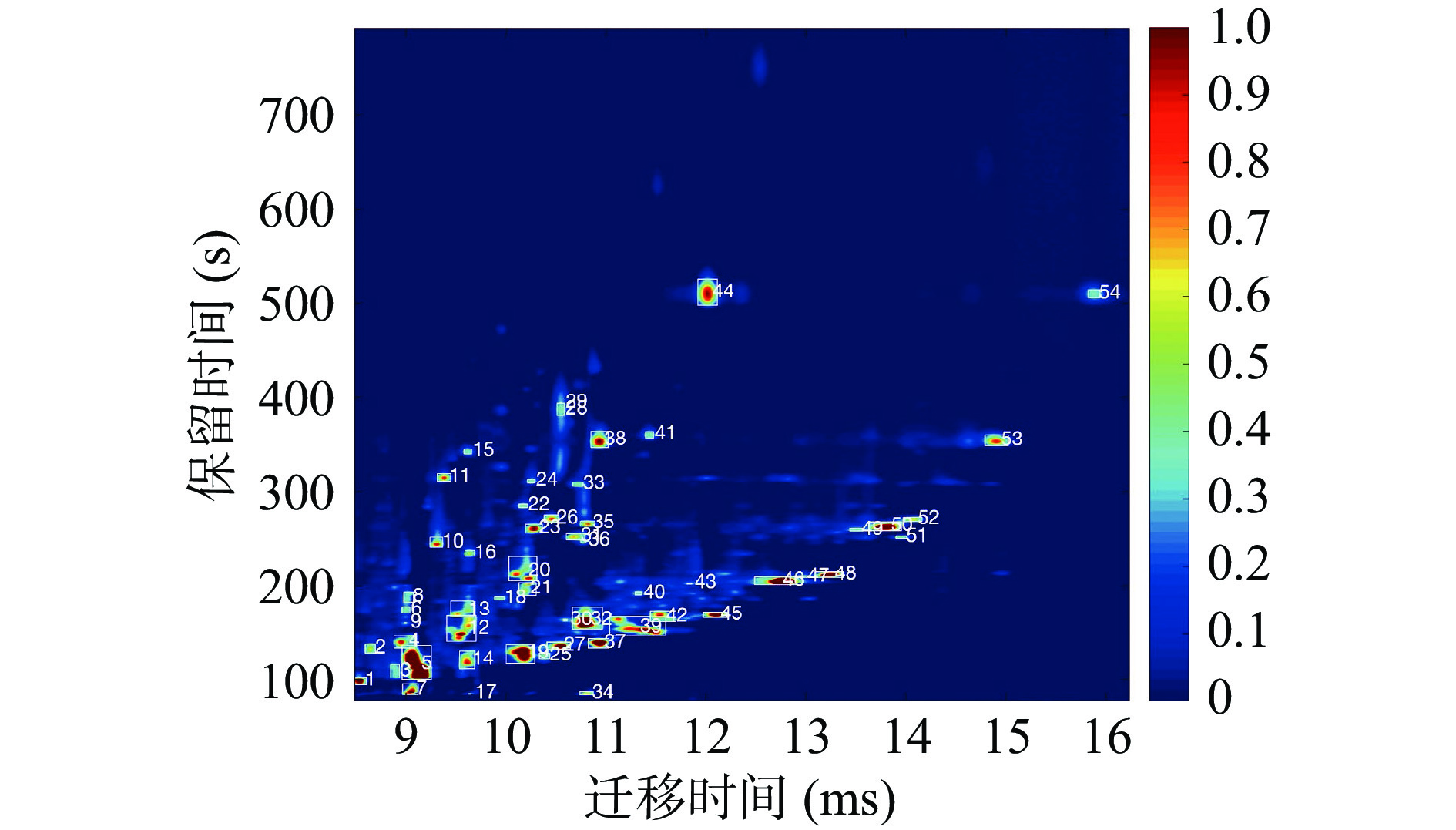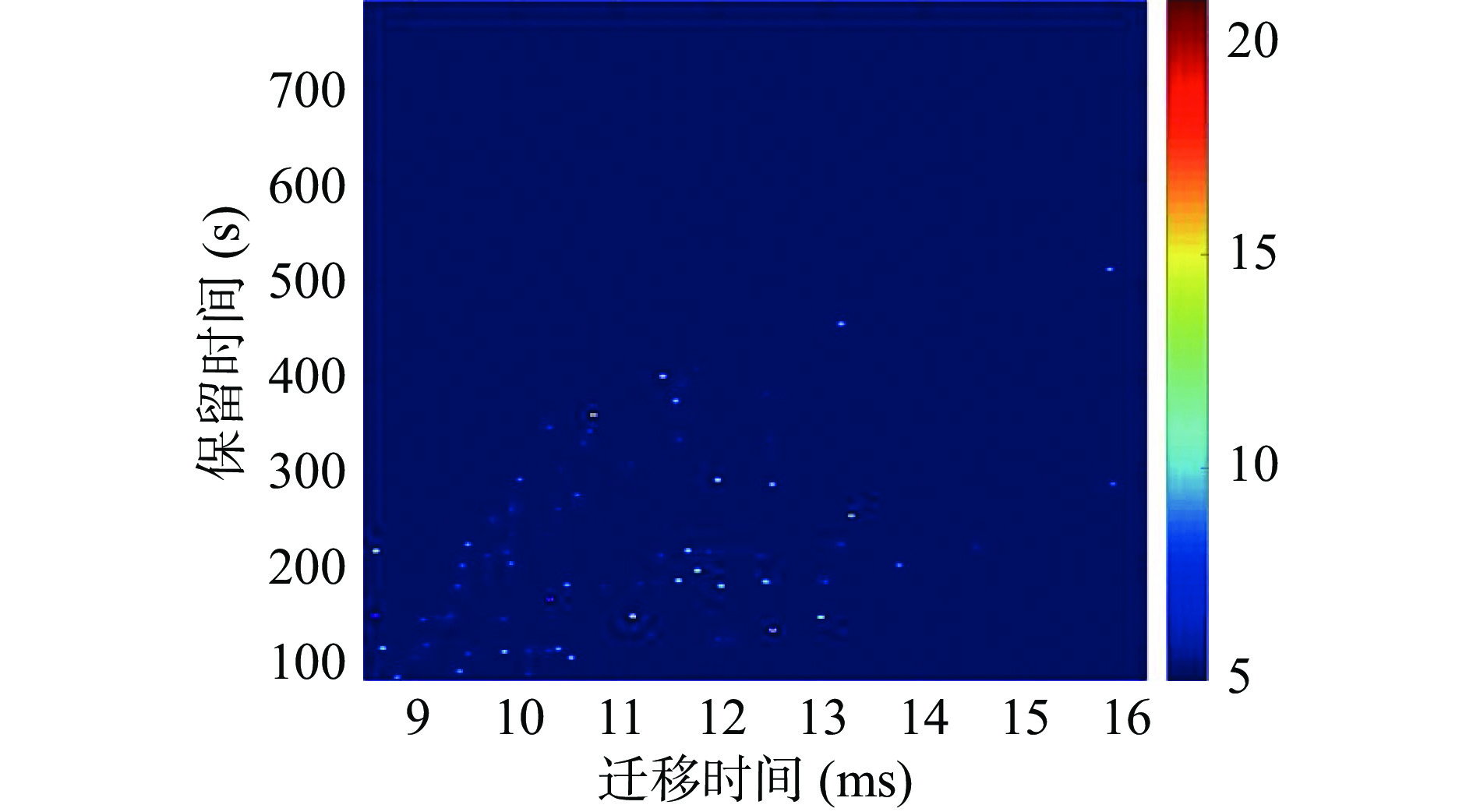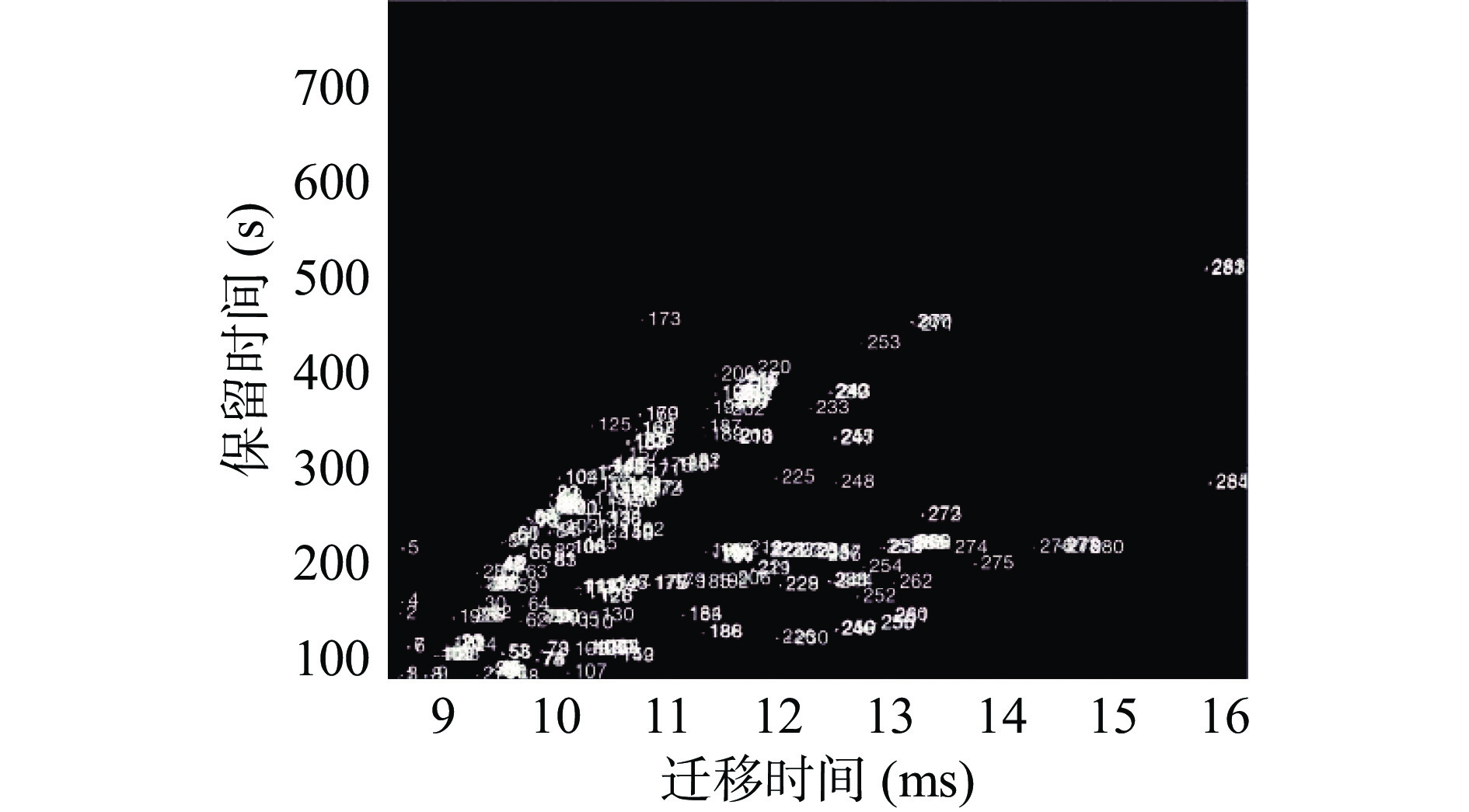Sharing Flavour Fingerprints Analysis of Fragrant Rice Based on GC-IMS Technology
-
摘要: 为提取广西香米中的共享风味指纹信息,实现广西、五常区域香米样品的快速判别,本研究采用气相离子迁移谱(Gas chromatography-ion mobility Spectrometry,GC-IMS)分析53个香米样品的挥发性风味物质成分,采用图谱预处理结合自动阈值分割方法提取二维图谱中能够表征广西香米中共有风味成分变量,并进行主成分分析(Principal component analysis,PCA),并使用二次线性判别分析(Quadratic discriminant analysis, QDA)建立2类区域香米样品的判别模型。结果表明,采用自动阈值分割方法共提取了广西香米样品中285个共享特征变量,2类样品在主成分得分图中均有各自的归属区域,QDA判别结果表明2类香米样品的识别率达到100%,可实现2类香米样品的准确判别。综上,数字图像处理结合化学计量学方法可有效提取GC-IMS二维图谱中的特征信息变量,实现香米品质的快速、无损、准确分析,也为其他类似联用仪器的多维特征信息提取提供了一种分析方法。
-
关键词:
- 香米 /
- 气相离子迁移谱(GC-IMS) /
- 风味指纹 /
- 化学计量学
Abstract: In order to extract the shared flavour fingerprint information from Guangxi fragrant rice and to rapidly realize the discrimination of fragrant rice between Guangxi and Wuchang regions, a total of 53 fragrant rice samples were collected and gas chromatography-ion mobility spectrometry (GC-IMS) technology was used to analyze the volatile flavor components. Based on the image pretreatment and automatic threshold segmentation algorithm, the shared flavour components of Guangxi fragrant rice were extracted in the two-dimensional map, and quadratic discriminant analysis (QDA) combined with principal component analysis (PCA) was applied to establish the qualitative model for distinguishing two different regions of fragrant rice. The results showed that 285 shared characteristic variables were extracted from fragrant rice by using the automatic threshold segmentation method. The first two principal component scores showed that each region of fragrant rice had their own corresponding areas. The discriminant model indicated that the recognition rate of two regions of fragrant rice could reach 100%, which could be used to estimate the discrimination between fragrant rice samples. In conclusion, digital image processing technology combined with chemometrics could effectively extract characteristic flavour variables from the two-dimensional map, which could achieve the rapid, non-destructive and accurate analysis in fragrant rice quality based on GC-IMS technology, and also provide an analysis method for multi-dimensional information for other similar instruments. -
香米因香味浓郁,经济价值高等特点,在国际稻米贸易中占有重要地位[1]。由于香米价格高于其他普通大米,部分生产者易受利益驱使在香米中添加低档甚至劣质大米,冒充出售以牟取暴利[2]。广西作为我国优质大米的主要产地之一,其生产的特色香米也深受其害。因此,亟待开发一种香米品质检测的新方法,而风味指纹图谱为香米品质信息的客观可视化表征提供了可能[3]。
当前,相关学者基于风味物质成分对大米品质进行了深入研究,其分析检测方法也从传统的感官评定[4-6]、理化指标[7]等方法扩展到光谱法[8]、色谱法[9]、核磁共振法[10]、电子鼻[11-13]以及气相色谱-质谱[14-16](Gas Chromatography-Mass Spectrometry, GC-MS)等联用分析技术。气相离子迁移谱(Gas Chromatography-Ion Mobility Spectrometry, GC-IMS)作为一种联用分析技术,充分发挥了气相色谱的高效分离效能与离子迁移谱的高灵敏度优势,通过配备自动顶空进样装备可实现固态、液态食品中痕量挥发性有机成分的定性、定量检测,具有无需样品预处理、简便快捷、绿色无损以及重复性好的优势[17-19]。Zhang等[20]使用GC-IMS和GC-MS技术对正常大米和黄变米中的挥发性代谢产物进行了研究,结合化学计量学方法实现了两者的区分,筛选出的己醛、壬醛、辛醛、1-戊醇和2-戊基呋喃等物质可作为大米黄变的潜在标记,为大米黄变机理的研究提供了依据。Ju等[21]使用GC-IMS对大米品种鉴别与掺假检测进行了研究,结果表明:不同品种大米预测准确率达到98.00%,掺假识别率达到97.30%,表明GC-IMS技术在准确预测大米品种与掺假大米方面具有一定的可行性。张志斌等[22]使用顶空固相微萃取技术结合GC-MS对4份贵州特色“香禾糯”品系材料与常规香稻大粒香的挥发性成分进行了对比分析,结果表明:香稻中的主要挥发性物质为烃类和醛类,不同品系香稻中的2-乙酰-1-吡咯啉、壬醛、庚醛、戊醛以及己醇等挥发性物质含量差异显著,表明所测特色香稻的挥发性物质区别于已有常规香稻,为进一步探究特殊香型产生的原理提供新思路。谷航等[23]使用GC-IMS技术监测了大米霉变过程中挥发性物质的变化,并建立了大米霉变早期预警的判别模型,结果表明:大米在不同霉变过程中产生的挥发性物质在种类和含量方面均存在显著差异,结合主成分分析与K-Means算法可有效区分大米的霉变程度,表明借助GC-IMS技术对大米霉变程度进行快速鉴定具有一定的可行性。综上所述,国内外关于GC-IMS技术在大米品质分析中的应用已有诸多报道,但研究方向多为挥发性物质的定性、定量分析,而针对GC-IMS二维图谱的特征提取方法研究较少,未能实现指纹图谱中特征峰的自动化识别[24-27]。因此,开发一种简便、快速、高效的GC-IMS二维图谱特征提取方法,实现香米风味品质的快速无损分析具有重要意义。
本文以市场上典型的2类香米(广西香米与五常香米)为研究对象,借助GC-IMS技术结合数字图像处理研究二维共享风味指纹谱的提取方法,并使用化学计量学方法实现两类香米的快速判别,以期实现GC-IMS图谱特征峰的自动选取,为类似联用技术在关键特征变量提取过程中提供一种分析方法,也为区域特色食品、农产品的产地识别与保护提供新的判别方法。
1. 材料与方法
1.1 材料与仪器
采用线上购买和线下收集2种方式采集广西和五常区域香米样品共53个,其中五常香米25个,广西香米28个,具体产地信息见表1。
表 1 香米样品的产地信息Table 1. Origin information for fragrant rice samples类型 样品数量(个) 品牌 产地 五常香米 25 稻花香 五常镇(2)、山河镇(2)、冲河镇(3)、杜家镇(2)、民意乡(2)、龙凤山镇(1)、红旗满族乡(2) 长粒香 二河乡(2)、安家镇(2)、民乐乡(2)、志广乡(2)、龙凤山镇(1)、小山子镇(2) 广西香米 28 国太 玉林(2)、来宾(2)、河池(1)、贺州(2) 广粮发 来宾(2)、柳州(3) 百香 柳州(1)、桂林(2)、河池(3) 丝香 南宁(4)、贵港(2)、玉林(2)、梧州(2) 注:产地名称括号内的数字为对应产地香米样品数量。 AR124CN型电子分析天平 奥豪斯仪器(常州)有限公司;CTC PAL RSI多功能自动顶空进样器 瑞士CTC Analytics AG公司;FlavourSpec®型GC-IMS分析仪 德国G.A.S公司。
1.2 实验方法
1.2.1 顶空进样条件
使用电子分析天平准确量取5 g待测香米样品置于20 mL顶空进样瓶中备用。孵育温度:90 ℃;孵育时间:10 min;孵化转速:500 r/min;顶空进样针温度:90 ℃;进样体积:500 μL。
1.2.2 GC条件
色谱柱SE-30(15 m×0.53 mm,1 µm);色谱柱温:40 ℃;载气:高纯N2(纯度≥99.999%);载气流量程序:初始2 mL/min,保持2 min,2~10 min内线性增加至15 mL/min,10~20 min线性增加至100 mL/min,20~30 min线性增加至150 mL/min,总分析时间为30 min。
1.2.3 IMS条件
漂移管温度:45 ℃;漂移管长度:9.8 cm;电场强度:500 V/cm;电离源:氚,正离子模式;漂移气流量:150 mL/min。
1.3 数据处理
运用Matlab R2019b(The Mathworks Inc.)和PRTools 5.1插件(Delft University of Technology Netherlands)对GC-IMS二维图谱数据进行可视化分析处理。
2. 结果与分析
2.1 香米二维图谱分析
由于每个香米样本对应的GC-IMS数据为一组二维矩阵,因此,采取Matlab软件对每类香米样品对应的数据矩阵进行均值处理,即计算所有样品矩阵每个元素位置对应数据组的均值,以每类样品GC-IMS的平均图谱表征样品的整体信息,并进行可视化显示。另外,由于每个样品对应的原始数据维度较大(3077×4500),因此,在尽可能保留原始图谱中挥发性风味物质特征峰的原则下,截取迁移时间为8.4870~16.2220 ms与保留时间78.3900~792.0900 s范围内的矩阵数据(1831×1161),结果如图1~图2所示。图1为广西香米样品的平均GC-IMS图谱,图2为以图1参比,五常香米样品的GC-IMS平均图谱对应的矩阵与参比(即广西香米平均图谱)的差值图谱。由图可知,2类香米样品含有部分相同的挥发性物质成分,如图1中虚线矩阵标记处,该区域在图2中对应区域位置未出现特征峰(即差值接近0),表明2类样品在该区域的挥发性风味成分含量接近;2类香米样品因条件差异(如产地气候、品种等)导致其产生的风味物质成分也不尽相同,图2中橙黄区域为五常香米中相较于广西香米含有的含量较高的挥发性风味物质(如图2中实线矩形框区域),而深蓝色区域则与之相反(如图2中箭头标记处)。综上可知,2类香米样品的挥发性风味成分中不仅含有相同的风味物质,同时每一类香米样品也含有其独有的风味物质成分,而如何提取一类香米样品中的共享风味物质成分实现判别分析需要进一步借助化学计量学方法进行处理。
2.2 广西香米共享风味指纹谱提取
为实现广西香米样品中共享特征风味信息的提取,首先采用自动阈值分割方法进行GC-IMS二维图谱特征提取[28-29],其效果如图3所示。由图可知,该香米样品中共有54个特征区域被捕获,采用该方法分别对两类香米样品进行特征区域提取,并记录识别出的特征区域质心位置的特征值(即离子强度值)。然后,计算广西香米样品的质心位置数据集合与五常香米样品数据的差值,并采用非平面球形结构元素进行膨胀处理得到样品的特征区域质心差异密度膨胀处理图,如图4所示。使用差值数据表征是为了后期剔除广西香米与五常香米共有的特征区域,而膨胀处理则为消除GC-IMS图谱X轴的波动,使得质心相近的特征点被视为同一特征区域。图4中通过颜色表可知橙红区域为广西香米样品特征区域质心位置集合,而深蓝色区域则为五常香米区域质心位置集合。最后,再次采用自动阈值分割方法对质心数据集合进行特征区域分割,即可筛选得到广西香米样品中共享特征区域质心集合,结果如图5所示。由图可知,广西香米样品中共识别出了285个特征区域信息,以质心位置对应的离子强度值集合作为香米风味品质的表征变量进行进一步分析。
2.3 二次线性判别分析
为进一步验证提取的特征峰的有效性,采用主成分分析(Principal Component Analysis, PCA)对特征变量集合(即53样品×285变量矩阵)进行处理。为对比验证所述方法的有效性,同时提取原始图谱中反应离子峰(Reactive Ion Peak, RIP)值为8.10 ms、保留时间为78.3900~792.0900 s范围内的单一色谱图为表征变量进行分析,GC-IMS图谱中反应离子的峰强度变化可以用来测量组分的产物离子生成,即反应离子峰强度的减少表明色谱柱的流出物中有分析物成分出现,该成分在漂移管反应区内产生了相应的产物离子,2种特征提取方法判别分析结果分别如图6和图7所示。由图6可知,提取的共享风味指纹谱特征变量经过PCA处理后,第1主成分贡献率为93.26%,第2主成分贡献率为5.74%,前2个主成分的累积贡献率为99.00%,表明经过PCA处理后原有的特征变量信息得到了保留;五常香米和广西香米均有各自归属的区域,其中广西香米样品在图6中呈狭长分布,而五常香米则呈椭圆状聚集,结合表1香米区域信息可知,产生该现象的主要原因为:广西区域采集的样品来源于整个自治区范围,区域跨度范围大,不同地级市之间的样品品质存在一定的差异,而五常香米对应的区域范围较单一,其区域仅仅为五常地级市范围;两类香米在图6中可明显分为2类,而图7中五常和广西两类香米样品的归属边界则明显重合,表明单一的一维向量处理方法取得的判别效果不佳;以共享风味指纹谱特征变量经PCA处理后的前2个主成分得分数进行二次线性判别分析(Quadratic Discriminant Analysis, QDA),结果如表2所示,由于采集的香米样品数量偏少,故未将样品集划分为校正集和预测集,仅将样品集用于建立判别模型以验证分析方法的可行性。由表2可知,所有产地香米样品的识别率均达到100%,表明该方法提取的特征指纹数据能够表征广西香米共有的风味品质信息。
表 2 香米样品QDA判别结果Table 2. Classification results of aromatic rice samples using quadratic linear discriminant analysis类型 广西香米 五常香米 预测率(%) 广西香米 28 0 100 五常香米 0 25 100 全部 28 25 100 3. 结论
本研究采用GC-IMS对广西香米和五常香米2类样品的挥发性风味成分进行检测,应用化学计量学方法结合数字图像处理技术建立了一种广西香米共享指纹图的提取方法,并实现了2类样品的准确判别。结果表明,图谱预处理结合图谱自动阈值分割方法可有效筛选特征风味变量,提取一类样品中的共享风味物质成分;同时,结合模式识别方法能够实现不同区域香米样品的判别。该方法为类似GC-IMS设备生成的二维图谱的解析处理提供了一种研究思路,同时也为国内区域香米的产地保护提供了一种新的分析方法和解决方案。
-
表 1 香米样品的产地信息
Table 1 Origin information for fragrant rice samples
类型 样品数量(个) 品牌 产地 五常香米 25 稻花香 五常镇(2)、山河镇(2)、冲河镇(3)、杜家镇(2)、民意乡(2)、龙凤山镇(1)、红旗满族乡(2) 长粒香 二河乡(2)、安家镇(2)、民乐乡(2)、志广乡(2)、龙凤山镇(1)、小山子镇(2) 广西香米 28 国太 玉林(2)、来宾(2)、河池(1)、贺州(2) 广粮发 来宾(2)、柳州(3) 百香 柳州(1)、桂林(2)、河池(3) 丝香 南宁(4)、贵港(2)、玉林(2)、梧州(2) 注:产地名称括号内的数字为对应产地香米样品数量。 表 2 香米样品QDA判别结果
Table 2 Classification results of aromatic rice samples using quadratic linear discriminant analysis
类型 广西香米 五常香米 预测率(%) 广西香米 28 0 100 五常香米 0 25 100 全部 28 25 100 -
[1] 梁奕, 庄海宁, 冯涛, 等. 大米及其衍生食品风味物质的研究进展[J]. 粮油食品科技,2021,29(1):41−49. [LIANG Y, ZHUANG H N, MA T, et al. Research progress on flavor substances of rice and its derivatives[J]. Science and Technology of Cereals, Oils and Foods,2021,29(1):41−49. LIANG Y, ZHUANG H N, MA T, et al. Research progress on flavor substances of rice and its derivatives[J]. Science and Technology of Cereals, Oils and Foods, 2021, 29(1): 41-49.
[2] 张敏, 张馥淳, 黄礼荣, 等. 影响大米品质的内在因素研究[J]. 现代面粉工业,2019,33(6):27−30. [ZHANG M, ZHANG F C, HUANG L R, et al. Study on internal factors affecting rice quality[J]. Modern Flour Milling Industry,2019,33(6):27−30. ZHANG M, ZHANG F C, HUANG L R, et al. Study on internal factors affecting rice quality[J]. Modern Flour Milling Industry, 2019, 33(6): 27-30.
[3] ZHAO Q Y, YOUSAF L, XUE Y, et al. Changes in flavor of fragrant rice during storage under different conditions[J]. Journal of the Science of Food and Agriculture,2020,100(8):3435−3444. doi: 10.1002/jsfa.10379
[4] 赵卿宇, 王占占, 陈博睿, 等. 大米储藏期间风味品质的变化研究[J]. 中国食品学报,2021,21(6):203−215. [ZHAO Q Y, WANG Z Z, CHEN B R, et al. Studies on the changes of flavor quality during rice storage[J]. Journal of Chinese Institute of Food Science and Technology,2021,21(6):203−215. ZHAO Q Y, WANG Z Z, CHEN B R, et al. Studies on the changes of flavor quality during rice storage[J]. Journal of Chinese Institute of Food Science and Technology, 2021, 21(6): 203-215.
[5] 王德生, 王睿, 商文婷, 等. 不同品种大米理化性质的探究[J]. 食品研究与开发,2021,42(11):8−16. [WANG D S, WANG R, SHANG W T, et al. Study on physicochemical properties of different rice varieties[J]. Food Research and Development,2021,42(11):8−16. doi: 10.12161/j.issn.1005-6521.2021.11.002 WANG D S, WANG R, SHANG W T, et al. Study on physicochemical properties of different rice varieties[J]. Food Research and Development, 2021, 42(11): 8-16. doi: 10.12161/j.issn.1005-6521.2021.11.002
[6] 陈焱芳, 张雁, 邓媛元, 等. 糙米挥发性风味物质分析技术及其在加工中变化研究进展[J]. 中国粮油学报,2020,35(8):160−169. [CHEN Y F, ZHANG Y, DENG Y Y, et al. Research progress in analysis technology of volatile flavor compounds in brown rice and its changes during processing[J]. Journal of the Chinese Cereals and Oils Association,2020,35(8):160−169. doi: 10.3969/j.issn.1003-0174.2020.08.026 CHEN Y F, ZHANG Y, DENG Y Y, et al. Research progress in analysis technology of volatile flavor compounds in brown rice and its changes during processing[J]. Journal of the Chinese Cereals and Oils Association, 2020, 35(8): 160-169. doi: 10.3969/j.issn.1003-0174.2020.08.026
[7] LU W, DONG X, QIU L L, et al. Colorimetric sensor arrays based on pattern recognition for the detection of nitroaromatic molecules[J]. Journal of Hazardous Materials,2016,326(15):130−137.
[8] JIANG H, LIU T, CHEN Q S. Dynamic monitoring of fatty acid value in rice storage based on a portable near-infrared spectroscopy system[J]. Spectrochimica Acta Part A: Molecular and Biomolecular Spectroscopy,2020,240:118620. doi: 10.1016/j.saa.2020.118620
[9] LIN J Y, FAN W, GAO Y N, et al. Study on volatile compounds in rice by HS-SPME and GC-MS[J]. Julius-Kühn-Archiv,2019:125−134.
[10] CAO R, LIU X R, LIU Y Q, et al. Applications of nuclear magnetic resonance spectroscopy to the evaluation of complex food constituents[J]. Food Chemistry,2021,342:128258. doi: 10.1016/j.foodchem.2020.128258
[11] 胡桂仙, 王俊, 王建军, 等. 基于电子鼻技术的稻米气味检测与品种识别[J]. 浙江大学学报(农业与生命科学版),2017,37(6):670−676. [HU G X, WANG J, WANG J J, et al. Detection for rice odors and identification of varieties based on electronic nose technique[J]. Journal of Zhejiang University (Agriculture & Life Sciences),2017,37(6):670−676. HU G X, WANG J, WANG J J, et al. Detection for rice odors and identification of varieties based on electronic nose technique[J]. Journal of Zhejiang University (Agriculture & Life Sciences), 2017, 37(6): 670-676.
[12] TAN J Z, XU J. Applications of electronic nose (e-nose) and electronic tongue (e-tongue) in food quality-related properties determination: A review[J]. Artificial Intelligence in Agriculture,2020,4:104−115. doi: 10.1016/j.aiia.2020.06.003
[13] MAIMUNAH M A, NORHASHILA H A, SAMSUZANA A A, et al. Principles and recent advances in electronic nose for quality inspection of agricultural and food products[J]. Trends in Food Science & Technology,2020,99:1−10.
[14] 崔琳琳, 赵燊, 周一鸣, 等. 基于GC-MS和电子鼻技术的大米挥发性风味成分分析[J]. 中国粮油学报,2018,33(12):134−141. [CUI L L, ZHAO S, ZHOU Y M, et al. Analysis of volatile flavors of rice based on gc-ms and electronic nose technology[J]. Journal of the Chinese Cereals and Oils Association,2018,33(12):134−141. doi: 10.3969/j.issn.1003-0174.2018.12.021 CUI L L, ZHAO S, ZHOU Y M, et al. Analysis of volatile flavors of rice based on gc-ms and electronic nose technology[J]. Journal of the Chinese Cereals and Oils Association, 2018, 33(12): 134-141. doi: 10.3969/j.issn.1003-0174.2018.12.021
[15] 黄亚伟, 徐晋, 王若兰, 等. HS-SPME/GC-MS对五常大米中挥发性成分分析[J]. 食品工业,2016,37(4):266−269. [HUANG Y W, XU J, WANG R L, et al. Analysis on HS-SPME/GC-MS technology in volatile components of wuchang rice[J]. The Food Industry,2016,37(4):266−269. HUANG Y W, XU J, WANG R L, et al. Analysis on HS-SPME/GC-MS technology in volatile components of wuchang rice[J]. The Food Industry, 2016, 37(4): 266-269.
[16] SETYANINGSIH W, MAJCHRZAK T, DYMERSKI T, et al. Key-marker volatile compounds in aromatic rice (Oryza sativa) grains: An HS-SPME extraction method combined with GC×GC-TOFMS[J]. Molecules,2019,24(22):4180−4195. doi: 10.3390/molecules24224180
[17] REYES G N, GOMEZ RIOS G A, SOUZA S E A, et al. Coupling needle trap devices with gas chromatography-ion mobility spectrometry detection as a simple approach for on-site quantitative analysis[J]. Journal of Chromatography A,2013,1300(14):193−198.
[18] ARMENTA S, ALCALA M, BLANCO M. A review of recent, unconventional applications of ion mobility spectrometry (IMS)[J]. Analytica Chimica Acta,2011,703(2):114−123. doi: 10.1016/j.aca.2011.07.021
[19] WANG S Q, CHEN H T, SUN B G. Recent progress in food flavor analysis using gas chromatography-ion mobility spectrometry (GC-IMS)[J]. Food Chemistry,2020,315:126158. doi: 10.1016/j.foodchem.2019.126158
[20] ZHANG X X, ZHEN D, FAN X J, et al. A study on volatile metabolites screening by HS-SPME-GC-MS and HS-GC-IMS for discrimination and characterization of white and yellowed rice[J]. Cereal Chemistry,2020,97(2):496−504. doi: 10.1002/cche.10264
[21] JU X G, LIAN F Y, GE H Y, et al. Identification of rice varieties and adulteration using gas chromatography-ion mobility spectrometry[J]. IEEE Access,2021,9:18222−18234. doi: 10.1109/ACCESS.2021.3051685
[22] 张志斌, 田瑞平, 吴娴, 等. 4份贵州特色香稻挥发性成分分析[J]. 分子植物育种,2021:1−19. [ZHANG Z B, TIAN R P, WU X, et al. Analysis of volatile components of four Guizhou types of fragrant rice[J]. Molecular Plant Breeding,2021:1−19. ZHANG Z B, TIAN R P, WU X, et al. Analysis of volatile components of four Guizhou types of fragrant rice[J]. Molecular Plant Breeding, 2021: 1-19.
[23] 谷航, 陈通, 陈明杰, 等. 气相-离子迁移谱联用技术评定大米霉变程度的应用研究[J]. 中国粮油学报,2019,34(9):118−124. [GU H, CHEN T, CHEN M J, et al. Application of gas chromatography-ion migration spectrometry (GC-IMS) to evaluate the degree of mildew in rice[J]. Journal of the Chinese Cereals and Oils Association,2019,34(9):118−124. doi: 10.3969/j.issn.1003-0174.2019.09.020 GU H, CHEN T, CHEN M J, et al. Application of gas chromatography-ion migration spectrometry(gc-ims) to evaluate the degree of mildew in rice[J]. Journal of the Chinese Cereals and Oils Association, 2019, 34(9): 118-124. doi: 10.3969/j.issn.1003-0174.2019.09.020
[24] 陈通, 吴志远, 王正云, 等. 基于气相离子迁移谱和化学计量学方法判别肉的种类[J]. 中国食品学报,2019,19(7):221−226. [CHEN T, WU Z Y, WANG Z Y, et al. Identification of meat species by gas chromatography-ion mobility spectrometry and chemometrics[J]. Journal of Chinese Institute of Food Science and Technology,2019,19(7):221−226. CHEN T, WU Z Y, WANG Z Y, et al. Identification of meat species by gas chromatography-ion mobility spectrometry and chemometrics[J]. Journal of Chinese Institute of Food Science and Technology, 2019, 19(7): 221-226.
[25] 杜萍, 陈振佳, 杨芳, 等. 基于顶空气相色谱-离子迁移谱技术的生咖啡豆快速鉴别方法[J]. 食品科学,2019,40(24):228−233. [DU P, CHEN Z J, YANG F, et al. A rapid method for the discrimination of different varieties of green coffee beans by headspace-gas chromatography-ion mobility spectrometry[J]. Food Science,2019,40(24):228−233. doi: 10.7506/spkx1002-6630-20190429-386 DU P, CHEN Z J, YANG F, et al. A rapid method for the discrimination of different varieties of green coffee beans by headspace-gas chromatography-ion mobility spectrometry[J]. Food Science, 2019, 40(24): 228-233. doi: 10.7506/spkx1002-6630-20190429-386
[26] 李俊杰, 徐元昊, 陈梦娟, 等. 手筑茯砖茶加工过程中挥发性组分变化分析[J]. 食品科学,2020,41(24):144−154. [LI J J, XU Y H, CHEN M J, et al. Analysis of changes in volatile components during processing of handmade fuzhuan tea[J]. Food Science,2020,41(24):144−154. doi: 10.7506/spkx1002-6630-20191226-316 LI J J, XU Y H, CHEN M J, et al. Analysis of changes in volatile components during processing of handmade fuzhuan tea[J]. Food Science, 2020, 41(24): 144-154. doi: 10.7506/spkx1002-6630-20191226-316
[27] CHEN T, LIU C Y, MENG L L, et al. Early warning of rice mildew based on gas chromatography-ion mobility spectrometry technology and chemometrics[J]. Journal of Food Measurement and Characterization,2021,15(2):1939−1948. doi: 10.1007/s11694-020-00775-9
[28] CHEN T, QI X P, LU D L, et al. Gas chromatography-ion mobility spectrometric classification of vegetable oils based on digital image processing[J]. Journal of Food Measurement and Characterization,2019,13:1973−1979. doi: 10.1007/s11694-019-00116-5
[29] YAO S, WU S, ZHOU Y, et al. Analysis of flavor components in HS-GC-IMS and antioxidant properties of black Lycium barbarum rice wine[J]. Journal of Food and Nutrition Research,2021,9(1):18−25. doi: 10.12691/jfnr-9-1-3
-
期刊类型引用(1)
1. 胡玥,孙红男,张苗,木泰华. 食物源肽与淀粉相互作用的研究进展. 食品科学. 2023(09): 163-169 .  百度学术
百度学术
其他类型引用(7)





 下载:
下载:







 下载:
下载:



